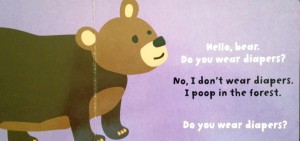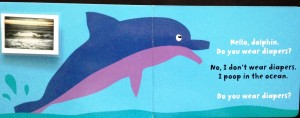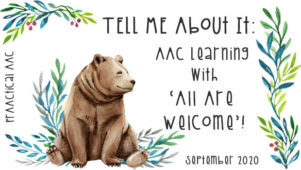AACtual Therapy: Building Language and Emergent Literacy Skills with ‘Do You Wear Diapers?’

What’s more fun than using story books to teaching language to young children with AAC  needs? Today, we hear from Kimberly Scanlon, an SLP practicing in New Jersey. Kimberley is is a devoted mom, wife and dog lover and blogs at Scanlon Speech and My Toddler Talks. She is the author of My Toddler Talks: Strategies and Activities to Promote Your Child’s Language Development and is finishing a unique picture and activity workbook, Learning to Read is a Ball.
needs? Today, we hear from Kimberly Scanlon, an SLP practicing in New Jersey. Kimberley is is a devoted mom, wife and dog lover and blogs at Scanlon Speech and My Toddler Talks. She is the author of My Toddler Talks: Strategies and Activities to Promote Your Child’s Language Development and is finishing a unique picture and activity workbook, Learning to Read is a Ball.
:::::::::::::::::::::::::::::::::::::::::::::::::::::::::::
Hold on to your undies, today we’re going to talk about poop, diapers, and the location of where various animals go potty.
Sounds like a good time, right?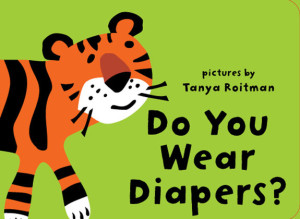
Kidding aside, in this post I’m going to show you how to use this adorable picture book, Do You Wear Diapers? by Tanya Roitman to facilitate language and emergent literacy development in toddlers and preschoolers.
What’s this book about?
It’s a potty book! This adorable board book encourages children to discover where different animals go potty.
Who’s best suited to participate in the activities that follow: –
- Children who like animals.
- Children who are curious about the potty or interested in becoming potty trained.
- Children who can physically turn pages, remove and apply laminated picture cards OR have someone assist them in these tasks.
When selecting a picture book, consider your child’s interests and likes. Currently, Do You Wear Diapers? is one of my daughter’s favorite books. Since she likes it, she’s motivated to sit down and read. When it comes to learning, young children must be motivated.
Why do I like this book?
- The illustrations are straightforward, clear, and colorful – not busy or overwhelming.
- There are various sentences (“No, I don’t wear diapers.”), carrier phrases (“I poop in the ________”) and questions (“Do you wear diapers?”) that REPEAT throughout the book. Repetitive lines are helpful in developing language because they are predictable – children know what’s coming next. When stories, routines, or pretty much anything in life is predictable, we devote more of our cognitive resources focusing on what’s new and different. Learning is easier because the cognitive load is reduced. Repetitive lines also give children multiple opportunities to hear and say certain words and phrases.
- The names of the animals in the story directly correspond to the picture on the page. This helps not only with oral language development, but also with emerging literacy skills.
How Can You Use This Book?
In the following 3 ways:
- Read and re-read it
Start by simply reading, “Do You Wear Diapers?”. If your child enjoys it, then re-read it! Research shows that re-reading books multiple times increases young children’s vocabulary.
- Play “Where’d He Go?”***
Since I’m working on developing my little girl’s receptive and expressive vocabulary, I don’t mind re-reading her favorite books. BUT, to keep MY interest, I spice things up a bit by playing this fun identification game.
“Where’d He Go?” is also great for those parents who love to ask “What’s this?” and “What’s that?” When I work with parents new to early intervention, I often witness how they innocently and unassumingly go into what I call – tester mode. They ask questions like, “What’s this?” and “What’s that?” as a way to elicit language. However, most toddlers, especially those with delays, don’t really appreciate this tester mode. Testing your little one zaps the fun and joy out of the whole experience.
Here’s how I play:
I give the book to my child and say something like:
“I can’t find the __________ (name one the six animals in the book). I also incorporate lots of gestural movements like scratching my head and raising my eyebrows) Where’d he go? Can you find the _______?
I like playing “Where’d He Go?” for the following reasons:
- Helps develop receptive language skills. Before a child can say a word, phrase, or sentence he usually has to understand and or be able to recognize, identify, and follow directions using those words.
- Takes the pressure off expecting a verbal response from the child.
- Gives the child a way to practice turning pages.
- Provides an opportunity to develop a child’s book knowledge by talking about the location of the animals in the book. For example, I can give my child a hint by saying something like “I think the tiger is at the beginning of the book. I think the ducks are at the end of the book.” Book knowledge helps develop emergent literacy skills.
**Language Elicitation Strategy:
When the child finds the animal, I give target specific feedback by saying something like, “Yay, you found the _________(insert name of animal). I repeatedly use this phrase so it becomes very familiar to the child (i.e. carrier phrase). Then, after doing this a few times, I include a pause and wait expectantly for the child to complete the sentence. So, I’ll say, “Yay, you found the ______pause (for about 3 to 5 seconds), point to the found animal while looking at your child with an expectant look.
*Can also be called “Where’d She go”?
**This strategy can be used with children who are becoming verbal as well as those who use a communication display.
- Adapt the book into a hands-on learning experience
Materials
Copy of Do You Wear Diapers?
*Laminated Images of animals in the book
I used Microsoft Clip Art and then shrunk them down to thumbnails, but here’s a great post on 5 Resources for Creating AAC and Visual Support Materials.
Velcro fasteners
For all you visual learners, here’s a picture of all the materials.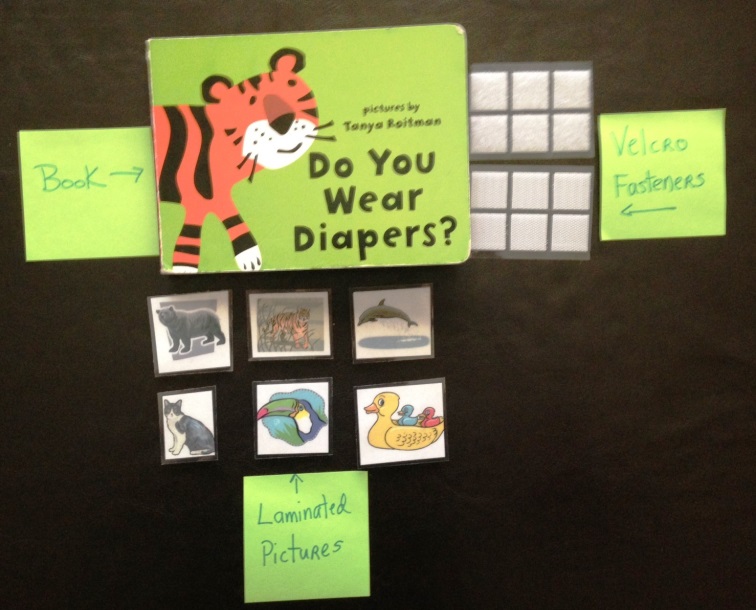
Once you have all these materials and your picture cards are laminated, place a Velcro sticker on the back of each laminated picture as well as on the book itself. Like this: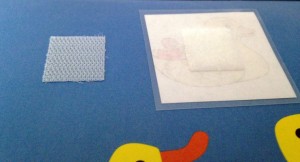
Procedure:
When you have everything in position, introduce the pictures. There are several ways to do this depending on your goals and or session objectives.
Typically, I start by giving the child a few images and having him or her match each laminated image to the corresponding picture in the book; similar to doing a puzzle. With this activity, the added sensory benefit is that the child can feel the Velcro and hear the sound it makes when pulling it off. My own daughter, who craves sensory input and movement, really enjoyed this tactile element.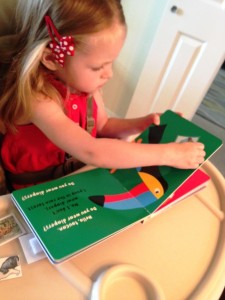
Here’s a picture of Kerrigan doing it all by herself (while I finish preparing dinner!):
Allow the child enough time to play and explore by him or herself. Independent play is important in developing a child’s confidence, creativity, and problem-solving skills. Your toddler may actually surprise you and match the pictures up themselves – applaud his or her efforts!
Once I feel the child is ready, I incorporate the laminated pictures into the reading.
Let’s look at the first picture in the book:
When I read the repeated carrier phrase, “No, I don’t wear diapers. I poop in the forest” I make my voice very animated, pretending to be the animal in the picture. I also hold up the laminated picture.
Often times, I delete saying “I don’t wear diapers.” Instead, I say:
“No, I poop in the ___________.”
I do this because I want to decrease the cognitive load and make it easier for the child to repeat the shorter phrase “No, I poop in the ________”.
Many of the children I treat, including my own daughter LOVE saying, “No” while emphatically shaking their heads. After the child verbally attempts to initiate or imitate “No” or any part of the carrier phrase, then I give him or her the laminated picture card to put on the Velcro. Pretty simple, but very fun and interactive!
Older Toddler or Preschool Twist – Introduce Locations of Where the Animals Poop
Do You Wear Diapers? tells the reader where the respective animals poop, but it does not show pictures of the locations. It’s up to the reader to imagine or visualize the locations. As a speech language pathologist though, I take it a step further by doing the following 2 things:
- I incorporate laminated picture cards of the locations of where the animals poop! Children benefit from such visual inputs.
- I’m not going to expect my toddler to immediately know or fully understand all of the locations (e.g. rainforest and jungle) simply by looking at pictures.
- I connect those locations to the child’s life experiences or interests! This is because it’s much easier for a child to recall and retain new vocabulary words if they can relate to it on some level.
For instance, my daughter knows the ocean because she’s seen the ocean and been in the ocean. She’s experienced it first-hand (probably why another favorite book is At the Beach). Therefore it is much easier for her visualize and recall that a dolphin poops in the ocean.
Some children may know litter box because they have cats. We do not have a cat and Kerrigan has never seen a litter box so the concept of a litter box is more abstract. BUT, to make this less abstract, I will make it my duty (not trying to be funny here J ) to say to Kerrigan when we do see a cat’s litter box, “The cat poops in the litter box, just like in the book Do You Wear Diapers?”
I hope you have enjoyed this post!
Filed under: PrAACtical Thinking
Tagged With: Books, emergent literacy, Kimberly Scanlon, potty, preschoolers, reading
This post was written by Carole Zangari
